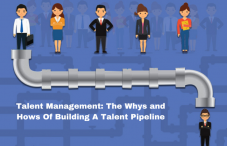It has been a year into the pandemic and now businesses are moving from survival strategies to continuity and expansion mode. While the world slowed down for the pandemic, a lot of companies took that opportunity to build a talent pipeline that they would need when the situation returned to normal and businesses grow owning to the surge in demand.
What is a talent pipeline?
Talent pipeline is a part of a proactive recruitment strategy. It refers to a pool of prospective & potential candidates that can be hired as and when the need arises. These can be either existing company employees who have been identified for promotion or lateral movement, or they can be external candidates.
Why do you need to build a talent pipeline?
There are various advantages to having a pool of talented candidates identified and ready.
- Saves time & money – having a pool of qualified candidates helps cut down the hiring time & cost attached with identifying and selecting candidates.
- Better candidates – you can identify and get access to better qualified & skilled candidates that can be hired as and when the positions come up.
- Create a diverse pool – creating a talent pool allows you the opportunity to include diverse candidates irrespective of gender, race, region, etc.
- Improve brand image – Talent pipeline focuses on building and maintaining a relationship with passive talent, thereby helping create a good employer brand image.
How can you build an effective talent pipeline strategy?
Creating a talent pipeline strategy needs time & effort but once done right, it helps hire the best people for the role in the shortest time.
Let us look at how you can start building your talent pipeline strategy.
Identify your future needs
Start with identifying roles that would require building a talent pipeline. Roles that need highly skilled talent or highly experienced candidates are a good starting point. Understand the company’s short-term and long-term goals and work out the skills requirement based on that.
Building a talent pipeline needs thorough planning and allocation of resources. Hence it is important to clearly plan out the critical roles like executive-level positions, specialised skilled professionals & other important positions.
Create a pool of internal candidates
Once you have identified the roles, you can either look for suitable candidates internally or source them externally. It is always a good idea to create your pool of internal candidates that can be trained to take up managerial or leadership roles.
You can also invest in upskilling suitable candidates for highly skilled positions. This is a great way to motivate the employees to perform better and improve retention. It also helps augment the brand image of the organisation which in turn helps attract better talent. For the organisation, it is a very cost-effective and highly efficient way of creating a great workforce.
Once you have identified potential candidates, inform them and coach them to take up the role when the position comes up.
Create a pool of External candidates
Looking for a candidate when the position comes up is a very reactive approach and it costs time and money. A better strategy is to create a pool of skilled and experienced candidates who can be approached and hired when the need arises.
There are various ways in which you can build your talent pipeline.
Company’s career page – Use the career page on your website to showcase the company’s culture and values. It is a great way to show the candidates what life in your company is like and attract top talent.
Social media handles – Your social media handles can also help you create a great talent pool of candidates. According to Glassdoor, as high as 79% of job applicants use social media while searching for jobs. Social media should be used not just for posting jobs, but for creating a strong employer brand image and engaging prospective candidates. Create a bond with them by sharing employee experiences, real-life stories, achievements, etc.
Keep in touch with the rejected candidates – It is a good idea to be in touch with candidates that were rejected at the final stage. They are qualified enough to have made it to the final round. You can save time by eliminating the initial stages of selection. If you have worked on creating a good candidate experience, you would most likely have created a good impression on them by respecting their time and providing proper & timely information during the last interview process. They would be more than willing to join your organisation when offered a chance again.
A good talent pipeline will help you draw the best people to work for you. It is a proactive approach that works for both the company and the candidates. Start working on your talent pipeline today.
Get in touch with us at www.flexiventures.in, the best staffing company in India to build your future-ready workforce!

